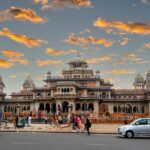Fees and Timing for Visiting Jaipur Monuments
Jaipur, the capital city of Rajasthan, India, is a treasure trove of history and culture, boasting magnificent forts, palaces, and architectural wonders that reflect its royal heritage. Visiting Jaipur’s monuments allows travelers to step back in time and experience the opulence and grandeur of Rajasthan’s erstwhile rulers. To help you plan your visit effectively, it’s crucial to understand the entry fees, timings, and essential information about these historical landmarks.
Overview of Jaipur’s Monuments
Jaipur is famous for its well-preserved forts, palaces, and other historical sites, each offering a unique glimpse into the city’s rich past. Here are some of the must-visit monuments in Jaipur:
Amber Fort (Amer Fort): Situated on a hilltop overlooking Maota Lake, Amber Fort is renowned for its blend of Rajput and Mughal architecture. The fort complex includes palaces, gardens, and temples, making it a significant attraction in Jaipur.
City Palace: Located in the heart of Jaipur, City Palace is a sprawling complex of courtyards, gardens, and buildings, showcasing a fusion of Rajput, Mughal, and European architectural styles. It houses the Chandra Mahal and Mubarak Mahal among other structures.
Hawa Mahal: Known as the Palace of Winds, Hawa Mahal is an iconic five-story palace with a unique honeycomb facade. It was built to allow royal women to observe street festivals while remaining unseen from the outside.
Jantar Mantar: Built by Maharaja Jai Singh II, Jantar Mantar is an astronomical observatory and UNESCO World Heritage site. It houses various instruments designed for astronomical measurements and observations.
Jaigarh Fort: Perched on the Aravalli hills, Jaigarh Fort is known for housing the world’s largest cannon on wheels, Jaivana. It offers stunning views of the surrounding landscape and is connected to Amber Fort through fortified passages.
Entry Fees and Categories
Entry fees for Jaipur’s monuments vary based on nationality and sometimes include additional charges for specific sections or camera usage. Here’s an overview of the current entry fees (as of 2024):
- Amber Fort:
- Indian Citizens: Approximately INR 100
- Foreign Tourists: Approximately INR 500
- Additional Charges: Camera fee applies
- City Palace:
- Indian Citizens: Approximately INR 200
- Foreign Tourists: Approximately INR 700
- Special Exhibits: Additional charges may apply for entry to specific sections or museums within the palace complex.
- Hawa Mahal:
- Indian Citizens: Approximately INR 50
- Foreign Tourists: Approximately INR 200
- Jantar Mantar:
- Indian Citizens: Approximately INR 50
- Foreign Tourists: Approximately INR 200
- Jaigarh Fort:
- Indian Citizens: Approximately INR 85
- Foreign Tourists: Approximately INR 300
- Combined Ticket: Often part of a combined ticket with Amber Fort
Timings for Visiting Jaipur Monuments
Understanding the operating hours of Jaipur’s monuments is crucial for planning your itinerary:
- Summer Timings (March to September): Monuments typically open from early morning (around 8:00 AM) to late afternoon (around 5:30 PM) to take advantage of longer daylight hours.
- Winter Timings (October to February): Due to shorter daylight hours, monuments may close slightly earlier, around 5:00 PM.
However, specific timings can vary seasonally and occasionally due to festivals or special events. It’s advisable to check the official websites or local tourism information centers for the most up-to-date timings before planning your visit.
Tips for Visitors
To make the most of your visit to Jaipur’s monuments, consider the following tips:
- Guided Tours: Many monuments offer guided tours in multiple languages, providing insightful information about the historical significance and architectural details.
- Photography: While photography is generally allowed at most monuments, there may be restrictions or additional fees for using cameras or tripods, especially in sensitive areas or during cultural events.
- Comfortable Attire: Jaipur experiences hot summers, so wearing light, comfortable clothing and carrying water is advisable during your exploration of these historical sites.
- Plan Ahead: Create an itinerary based on the proximity of monuments and their opening hours to optimize your time and avoid rushing through visits.
- Cultural Sensitivity: Respect local customs and regulations while visiting religious sites within the monuments, such as temples or sacred areas.
Conclusion
Visiting Jaipur’s monuments offers a captivating journey through Rajasthan’s royal history, from the grandeur of Amber Fort to the architectural marvels of City Palace and the scientific precision of Jantar Mantar. By understanding the entry fees, timings, and essential tips provided, you can ensure a memorable and enriching experience exploring these cultural treasures.
For more information and to plan your Rajasthan tour package, visit Rajasthan Bhumi Tours.
Q 1.: What are several of the notable monoliths to check out in Jaipur?
A: Jaipur flaunts a number of remarkable monuments, consisting of Brownish-yellow Ft, City Palace, Hawa Mahal, Jantar Mantar, and Jaigarh Fort. Each offers an one-of-a-kind point of view on the city’s abundant history and architectural heritage.
Q 2. : What is unique concerning Brownish-yellow Fort?
A: Amber Fort, additionally referred to as Amer Fort, is renowned for its picturesque location on a hill forgeting Maota Lake. It showcases a mix of Rajput and Mughal architectural styles, including palaces, yards, and holy places within its extensive complex.
Q 3.: Just how much are the entry charges for these monuments?
A: Entry charges vary by monolith and visitor race.
As an example: Brownish-yellow Ft: INR 100 for Indian residents, INR 500 for international travelers.
City Palace: INR 200 for Indian citizens, INR 700 for foreign travelers.
Hawa Mahal: INR 50 for Indian citizens, INR 200 for international tourists.
Jantar Mantar: INR 50 for Indian people, INR 200 for international travelers.
Jaigarh Ft: INR 85 for Indian citizens, INR 300 for international vacationers.
Q 4.: Are there any kind of service charges besides entrance charges?
A: Yes, some monoliths may bill additional for particular sections or facilities such as cam usage. For instance, Brownish-yellow Ft has an added charge for video cameras.
Q 5.: What are the timings for checking out these monoliths?
A: Monuments usually open from around 8:00 AM to 5:30 PM during summer (March to September) and close around 5:00 PM during wintertime (October to February). Timings can vary, so it’s suggested to check official internet sites or regional tourism details for the most exact information.
Q 6.: What tips can improve the check out to Jaipur’s monoliths?
A: To maximize your check out: Take into consideration joining assisted tours used at several monoliths to get much deeper understandings. Regard digital photography rules and cultural sensitivities, especially in sacred areas. Gown easily, specifically in Jaipur’s cozy environment, and bring water throughout your expeditions. Strategy your travel plan to enhance your time and prioritize visits based on proximity and opening hours. Respect regional customizeds and guidelines, especially when checking out religious sites within the monuments.
Q 7.: Why is Jaipur taken into consideration a must-visit for travelers interested in background and culture?
A: Jaipur’s monoliths supply a fascinating trip via Rajasthan’s royal history, showcasing architectural splendors, scientific advancements (like at Jantar Mantar), and cultural splendor that mirrors the city’s royal past. This blend makes Jaipur a compelling location for background enthusiasts and cultural explorers alike.



